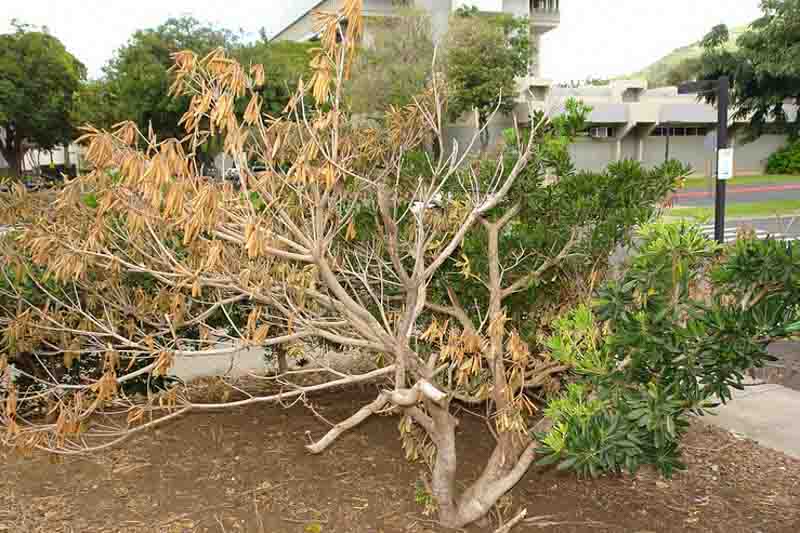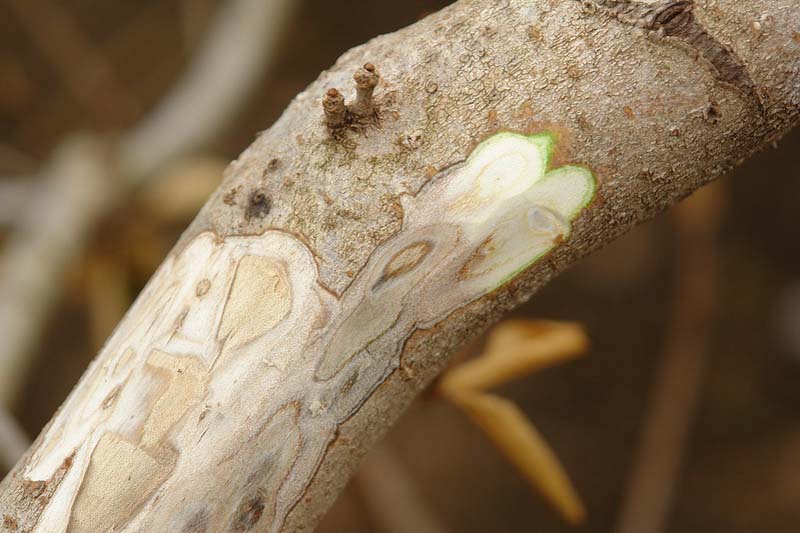Botryosphaeria dieback is a fungal disease that attacks weakened or stressed plants, particularly woody shrubs and trees
Botryosphaeria canker and dieback is a serious fungal disease affecting a wide range of woody plants. It is caused by various species within the fungal genus Botryosphaeria. It is particularly detrimental to stressed plants and can lead to severe dieback or even the death of the host plant.
Botryosphaeria canker and dieback are prevalent in many parts of the world, particularly in temperate and subtropical regions. Stressful environmental conditions like drought or extreme temperatures often exacerbate its spread.
This disease has a broad host range, affecting numerous types of trees and shrubs:
Apple, arborvitae, ash, aucuba, azalea, barberry, beech, birch, black gum, buckeye, camellia, cherry, cherry laurel, chokecherry, cotoneaster, crab apple, crape myrtle, cypress, dogwood, Douglas fir, eastern red cedar, elm, euonymus, false cypress, fir, forsythia, giant sequoia, hickory, holly, honey locust, honeysuckle, hypericum, juniper, lilac, linden, magnolia, maple, mountain laurel, oak, pear, pecan, persimmon, Pieris, pine, pittosporum, poplar, privet, prunus, pyracantha, robinia, redbud, rhododendron, rose, serviceberry, spirea, spruce, sumac, sweet gum, sycamore, tulip tree, viburnum, walnut, willow, wisteria, witch hazel, yew, zelkova.
Botryosphaeria canker and dieback is caused by fungi in the Botryosphaeria genus. These fungi commonly infect plants through wounds, natural openings, or areas of stress, such as cracks in the bark or pruning cuts. The fungi are opportunistic pathogens, meaning they are more likely to infect plants that are already stressed or weakened by other factors.
Here are some common causes and contributing factors:
Understanding the contributing factors can help in implementing effective preventive measures. Reducing plant stress through proper care and avoiding unnecessary wounding can go a long way in preventing infection.

The symptoms of Botryosphaeria canker and dieback can vary depending on the host plant, but some common signs are generally associated with this fungal disease:
Cankers: The most distinct symptom is the formation of cankers, which are sunken, darkened areas on stems or branches. The cankers may ooze sap or resin.
Dieback: Branches and twigs may exhibit dieback, starting from the tips and progressing inward. In some cases, the entire branch may die.
Discolored Foliage: Foliage may turn yellow, red, or brown, often before premature dropping from the plant.
Reduced Growth and Vigor: Infected plants usually show reduced growth and may look stunted compared to healthy plants.
Wilting: Even with adequate water, you may notice wilting of leaves and young shoots, particularly if the canker has girdled the stem or branch, restricting water and nutrient flow.
Fungal Structures: You may see small fruiting bodies (pycnidia) forming on the surface of the cankers. These are the reproductive structures of the fungus and are often a black or dark brown color.
Splitting Bark: The bark around the canker may split or peel away, revealing the discolored wood underneath.
Early detection of these symptoms can be crucial for effectively managing the disease. Regularly inspecting your plants, particularly during the growing season and following any periods of environmental stress, will help you catch any developing issues before they become severe.

Controlling and preventing Botryosphaeria canker and dieback involves a multi-pronged approach that includes cultural practices, chemical treatments, and sometimes biological controls. Here are some strategies:
By employing these control and preventive measures, you can reduce the chances of Botryosphaeria canker and dieback affecting your plants and manage the disease more effectively if it does appear. Always consult local extension services or plant pathologists for the most localized advice.
Create a membership account to save your garden designs and to view them on any device.
Becoming a contributing member of Gardenia is easy and can be done in just a few minutes. If you provide us with your name, email address and the payment of a modest $25 annual membership fee, you will become a full member, enabling you to design and save up to 25 of your garden design ideas.
Join now and start creating your dream garden!
Create a membership account to save your garden designs and to view them on any device.
Becoming a contributing member of Gardenia is easy and can be done in just a few minutes. If you provide us with your name, email address and the payment of a modest $25 annual membership fee, you will become a full member, enabling you to design and save up to 25 of your garden design ideas.
Join now and start creating your dream garden!